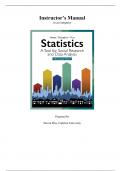Instructor’s Manual to accompany Prepared by Steven Prus , Carleton University Copyright © 2023 Cengage Learning Canada, Inc. iii TABLE OF CONTENTS Preface ................................ ................................ ................................ .............................. iv Chapter 1: Introduction ................................ ................................ ................................ .. 1-1 Chapter 2: Basic Descriptive Statistics: Percentages, Ratios and Rate s, Tables, Charts, and Graphs ................................ ................................ ................................ ......... 2-1 Chapter 3: Measures of Central Tendency and Dispersion ................................ ........... 3-1 Chapter 4: The Normal Curve ................................ ................................ ........................ 4-1 Chapter 5: Introduction to Inferential Statistics: Sampling and the Sampling Distribution ................................ ................................ ................................ .... 5-1 Chapter 6: Estimation Procedure s for Sample Means and Proportions ......................... 6-1 Chapter 7: Hypothesis Testing with Nominal and Ordinal Variables : Chi Square ....... 7-1 Chapter 8: Measures of Association for Variables Measured at the Nominal Level ..... 8-1 Chapter 9: Measures of Association for Variables Measured at the Ordinal Level ...... 9-1 Chapter 10: Hypothesis Testing with Means and Proportions : The One -Sample Case ................................ ................................ ................................ .. 10-1 Chapter 11: Hypothesis Testing with Means and Proportions : The Two -Sample Case ................................ ................................ ................................ . 11-1 Chapter 12: Hypothesis Testing with More Than Two Means : One-Way Analysis of Variance ................................ ................................ ................................ ................... 12-1 Chapter 13: Hypothesis Testing and Measures of Association for Variables Measured at the Interval -Ratio Level ................................ ................................ ........................... 13-1 Chapter 14: Partial Correlation and Multiple Regression and Correlation .................. 14-1 Copyright © 2023 Cengage Learning Canada, Inc. iv CHAPTER 1 INTRODUCTION SUMMARY Statistics: A Tool for Social Research, Fifth Canadian Edition , begins by explaining the role of statistics in the research process. T he discussion is guided by ―The Wheel of Science ,‖ as conceptualized by Walter Wallace (Figure 1.1). The text consistently presents statistics in the context of the research enterprise ; that is, statistics are always presented not as ends in themselves, but as useful devices or tools for answering questions and testing theories. The chapter also distinguishes between descriptive and inferential statistics , and between univariate, bivariate, and multivariate statistics. The distinction between discrete an d continuous variables and the concept of level of measurement are presented as well . The latter is stressed throughout the text as an organizational device and as a major criterion for selecting statistics appropriately. Exercises are provided at the end of the chapter for reviewing the characteristics of the three levels of measurement used in this text. NEW TO THE FIFTH CANADIAN EDITION The ― You are the Researcher ‖ section has been updated with new survey data , the 2018 GSS and CCHS . WHAT CAN I DO IN CLASS? 1. Provide students with a table consisting of a variable (Column 1) , the variable’s response categories (Column 2), whether it is independent or dependent (Column 3), and the level of measurement (Column 4). Ask students to identify the variables as independent or dependent , as well as the level of measurement for each given variable. Go over the answers in class. For example, gender is an independent nominal -level variable and health is a dependent variabl e measured at either the interval -ratio (body weight in kilograms ), ordinal (poor, good, or excellent self -rated health ), or nominal (have a family doctor, yes or no) level . 2. Show a list of examples of populations and samples , and have students identify each as such. For example, we want to know if more male students or more female students visit the local pub on campus in a given week . a. Sample: The number of male and female visitors you observe visiting during a one-hour period b. Population: Everyone who visits the local pub on campus in a given we ek Copyright © 2023 Cengage Learning Canada, Inc. v WHAT CAN I DO ONLINE? 1. Have students look up examples online of variables that can be identified as having more than one level of measurement , depending on how they are categorized. For example, household income can be reported as a continuous variable or grouped into finite categories (see, for example , https://www150. statcan.gc.ca/n1/en/catalogue/98 -400-X2016097 ). 2. Have students search a recent news story or report online and identify and list variables that could be used to conduct a quantitative analysis (see, for example, Angus Reid Institute ’s report on term care facilities in Canada during the COVID -
19 pandemic , https://angusreid.org/long -term-care-covid/ ). CHAPTER 2 BASIC DESCRIPTIVE STATISTICS Percentages, Ratios and Rates, Tables, Charts, and Graphs SUMMARY This chapter covers relatively simple descriptive devices: percentages and proportions, ratios, rates, frequency distributions, pie and bar charts , histograms, and frequency polygons . The emphasis is on frequency distributions and the construction and interpretation of these tables for variables measured at each of the three diff erent levels. Instructors may want to supplement this material with additional examples of each technique and/or graphs and charts, especially those created by software such as Microsoft Excel. The underlying theme of this chapter is the need to present results clearly , to communicate results accurately and concisely but without losing too much detail. The problem used in Section 2.6 : Charts and Graphs , for example, is intended to contrast the anarchy of raw, unorganized data with the clarity and simplici ty of frequency distributions and various graphs. NEW TO THE FIFTH CANADIAN EDITION Most tables, graphs, and application boxes have been updated to better reflect the underl ying relevance and importance of using basic descriptive statistics to help understand society. The SPSS exercises have been updated with the new Canadian survey data used in the textbook . ANSWERS TO TEXT PROBLEMS 2.1




